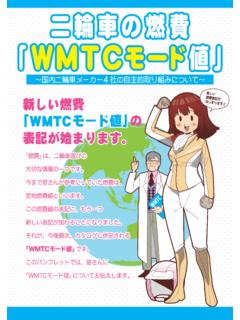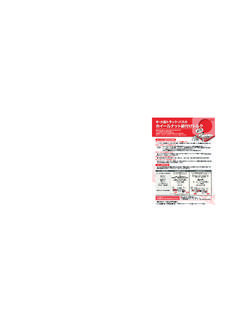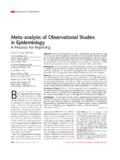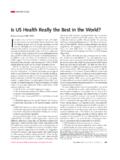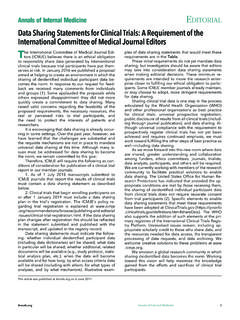Transcription of The International Registry of Acute Aortic …
1 ORIGINAL CONTRIBUTIONThe International Registryof Acute Aortic Dissection (IRAD)New Insights Into an Old DiseasePeter G. Hagan, MBChristoph A. Nienaber, MDEric M. Isselbacher, MDDavid Bruckman, MSDean J. KaravitePamela L. Russman, BSArturo Evangelista, MDRossella Fattori, MDToru Suzuki, MDJae K. Oh, MDAndrew G. Moore, MDJoseph F. Malouf, MDLinda A. Pape, MDCharlene Gaca, RNUdo Sechtem, MDSuzanne Lenferink, MDHans Josef Deutsch, MDHolger Diedrichs, MDJose Marcos y Robles, MDAlfredo Llovet, MDDan Gilon, MDSugata K. Das, MDWilliam F. Armstrong, MDG. Michael Deeb, MDKim A. Eagle, MDAuthor Affiliations:University of Michigan, Ann Ar-bor (Drs Hagan, Das, Armstrong, Deeb, and Eagle,Messrs Bruckman and Karavite, and Ms Russman); Mas-sachusetts General Hospital, Boston (Dr Isselbacher), andUniversity of Massachusetts, Worcester (Dr Pape andMs Gaca); Hospital General Universitari Vall d Hebron,Barcelona (Dr Evangelista), and Hospital 12 de Octubre,ContextAcute Aortic dissection is a life-threatening medical emergency associatedwith high rates of morbidity and mortality.
2 Data are limited regarding the effectof recent imaging and therapeutic advances on patient care and outcomes in assess the presentation, management, and outcomes of Acute series with patients enrolled between January 1996 and December1998. Data were collected at presentation and by physician review of International Registry of Acute Aortic Dissection, consisting of 12 inter-national referral total of 464 patients (mean age, 63 years; male), ofwhom had type A Outcome MeasuresPresenting history, physical findings, management, andmortality, as assessed by history and physician review of hospital sudden onset of severe sharp pain was the single most common pre-senting complaint, the clinical presentation was diverse. Classic physical findings suchas Aortic regurgitation and pulse deficit were noted in only and of pa-tients, respectively, and initial chest radiograph and electrocardiogram were fre-quently not helpful (no abnormalities were noted in and of patients,respectively).
3 Computed tomography was the initial imaging modality used in in-hospital mortality was Mortality of patients with type A dissectionmanaged surgically was 26%; among those not receiving surgery (typically becauseof advanced age and comorbidity), mortality was 58%. Mortality of patients with typeB dissection treated medically was Surgery was performed in 20% of patientswith type B dissection; mortality in this group was Aortic dissection presents with a wide range of manifestations,and classic findings are often absent. A high clinical index of suspicion is recent advances, in-hospital mortality rates remain high. Our data support theneed for continued improvement in prevention, diagnosis, and management of acuteaortic 2000;283 (Drs Marcos y Robles and Llovet), Spain; Uni-versity Hospital S Orsola, Bologna, Italy (Dr Fattori); Uni-versity of Tokyo, Tokyo, Japan (Dr Suzuki); Mayo Clinic,Rochester, Minn (Drs Oh, Moore, and Malouf); Uni-versity Hospital Eppendorf, Hamburg (Dr Nienaber),Robert-Bosch Krankenhaus, Stuttgart (Drs Sechtem andLenferink), and University of Cologne, Cologne(Drs Deutsch and Diedrichs), Germany; and HadassahUniversity Hospital, Jerusalem, Israel (Dr Gilon).
4 Corresponding Author and Reprints:Kim A. Eagle, MD,Division of Cardiology, Department of Internal Medi-cine, University of Michigan Medical Center, 1500 EMedical Center Dr, Ann Arbor, MI 48109-0366 (e-mail: 2000 American Medical Association. All rights ,February 16, 2000 Vol 283, No. 7897On 25 October 1760 George II, then 76, roseat his normal hour of 6AM, called as usual forhis chocolate, and repaired to the German valet de chambre heard a noise,memorably described as louder than the royalwind , and then a groan; he ran in and foundthe King lying on the floor, having cut his facein falling. Mr. Andrews, surgeon of the house-hold, was called and bled his Majesty but invain, as no sign of life was observed from thetime of his fall. At necropsy the next day , physician to his late Majesty, foundthe pericardium distended with a pint of co-agulated blood, probably from an orifice in theright ventricle, and a transverse fissure on theinner side of the ascending aorta cm long,through which blood had recently passed in itsexternal coat to form a raised ecchymosis, thisappearance being interpreted as an incipientaneurysm of the is very old, and nothing about it haschanged.)
5 It is we who change as we learn torecognize what was formerly imperceptible. Jean Martin CharcotACUTE Aortic DISSECTION IS Achallenging clinical emer-gency first described by Mor-gagni more than 200 1958, Hirst et al3reviewed 505patients with the condition, highlight-ing the high mortality rate and the in-frequency of antemortem to the introduction of cardiopul-monary bypass in the mid 1950s, sur-gical options were severely Debakey first reported surgical re-pair of a thoracic Aortic aneurysm, man-agement techniques have steadily , percutaneousfenestration and/or stent placementhave been used in select , diagnostic imaging modali-ties, including computed tomogra-phy, transesophageal echocardiogra-phy, and magnetic resonance imaging,have been developed and are dissection is the most com-mon Acute Aortic condition requiringurgent surgical of the layers within the Aortic wallcharacterizes dissection.
6 Blood entersthe intima-media space with furtherpropagation of the dissection. Typi-cally, 1 or more tears in the intimal layerallow communication between the 2 lu-mens. Intramural hematoma without anintimal tear is a distinct pathological le-sion that is being observed with in-creasing frequency. Presenting fea-tures are similar, and progression todissection may the ini-tiating event is unknown, most pa-tients have a structural abnormality ofthe arterial wall and/or systemic ,33-35 Classification of Aortic dissection isbased on anatomical location and timefrom onset. Stanford type A dissectionsinvolve the ascending aorta and type Bdissections occur distal to the left sub-clavian 14-day period af-ter onset has been designated the acutephase, because morbidity and mortal-ity rates are highest and surviving pa-tients typically stabilize during this presenting clinical featuresare diverse and serious complicationsoccur rapidly, antemortem diagnosishas proven ,37,38 One wouldpredict that the advent of modern im-aging combined with progress in bothsurgical and nonsurgical therapy shouldresult in improved outcomes.
7 Little isknown about the effect of these devel-opments. Therefore, The Interna-tional Registry of Acute Aortic Dissec-tion (IRAD) was established in 1996,enrolling patients at large referral cen-ters, to assess the current presenta-tion, management, and outcomes ofacute Aortic SelectionTwelve large referral centers in 6 coun-tries are participating in the Registry . Allpatients with Acute Aortic dissectionwere enrolled beginning January 1,1996. Patients were identified at pre-sentation or by searching hospital dis-charge diagnosis records and surgicaland echocardiography laboratory da-tabases. Diagnosis was based on his-tory, imaging study findings, visualiza-tion at surgery, and/or postmortemexamination. Patients with Aortic dis-ruption secondary to trauma were CollectionA questionnaire of 290 variables, de-fined according to standard defini-tions, including demographics, his-tory, physical findings, management,imaging studies, and outcomes, was de-veloped by IRAD collected at presentation or byphysician review of hospital records andwere forwarded to the IRAD Coordi-nating Center at The University ofMichigan.
8 Forms were reviewed forclinical face validity and analytical in-ternal validity. External validation wasperformed through a random (5%) fieldselection and error audit. More than33% of patient report forms were re-reviewed for validation by each AnalysisData analysis was performed using sta-tistical analysis software. Univariateanalyses were used to compare fre-quency, proportion, or distribution ofdemographic and comorbidity vari-ables between ,ttests, or nonparametricWilcoxon rank sum tests were appliedas appropriate. To determine a trendacross groups, regardless of condi-tion, the extended Mantel-Haenszel cor-relation statistic at 1dfwas used. Cat-egorical modeling was used to teststatistical trends and associations us-ing the likelihood ratio test for modeldetermination. Models were selected us-ing likelihood ratio tests, with a sig-nificance level of.
9 05. Corrections dueto multiple comparisons were used todetermine appropriate levels of of December 31, 1998, 464 pa-tients have been enrolled (TABLE1).Two thirds of those patients were age of all patients was years(95% confidence interval, ). Type A dissection was identi-fied in of patients. Patients withtype B dissection were, on average, older(P,.001). A history of cardiac surgerywas present in 83 patients ( ). Iat-rogenic dissection was reported in 20patients ( ). Sixty percent of patientsinitially presented to an outside hospi-tal and were referred to IRAD centersNEW INSIGHTS INTO Acute Aortic DISSECTION898 JAMA,February 16, 2000 Vol 283, No. 7 2000 American Medical Association. All rights continued management. A historyof hypertension was elicited in all patients.
10 Marfan syndrome waspresent in of all patients (meanage, 36 years; range, 13-52 years).Presenting Symptoms and SignsSevere pain was the most common pre-senting symptom, and of pa-tients recalled abrupt onset (TABLE2).The majority of patients complained ofchest pain ( ). Anterior chest painwas typical in patients with type A dis-section, whereas patients with type Bdissection more often experienced painin the back and abdomen, althoughthere was substantial overlap (P,.001).Of note, pain was described as sharpmore often than tearing or ripping. Hy-pertension at initial presentation wasmore common among patients withtype B dissection ( vs ,P,.001). One in 4 patients with typeA dissection had an initial systolic bloodpressure below 100 mm Hg. Whendocumented, a pulse deficit was notedmore often in patients with type A dis-section (P=.)

